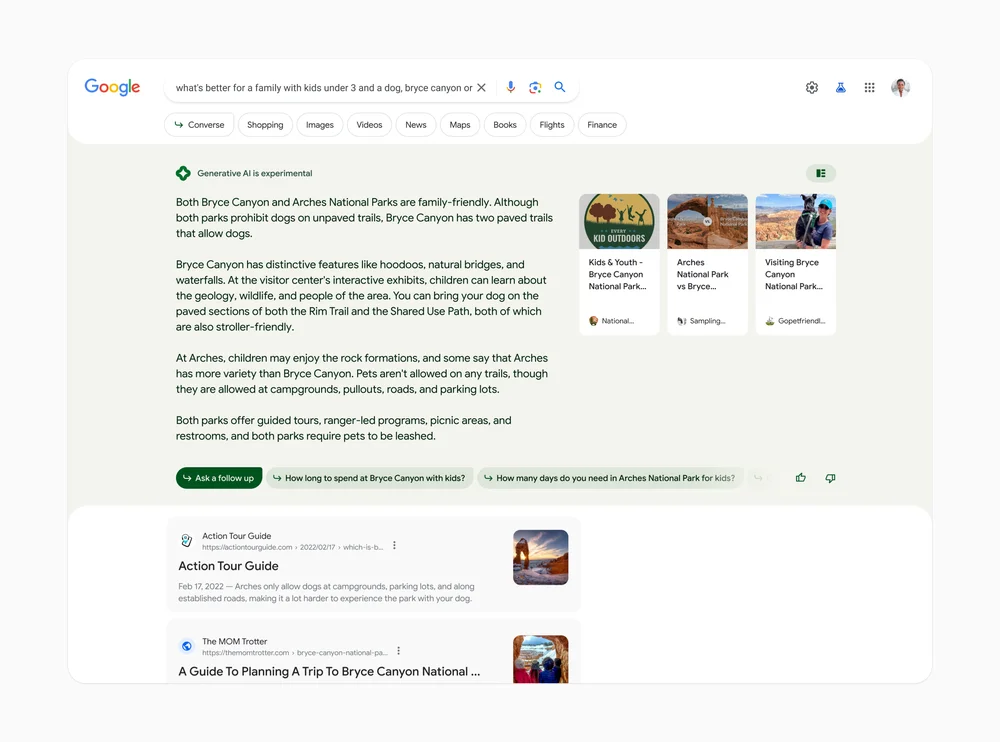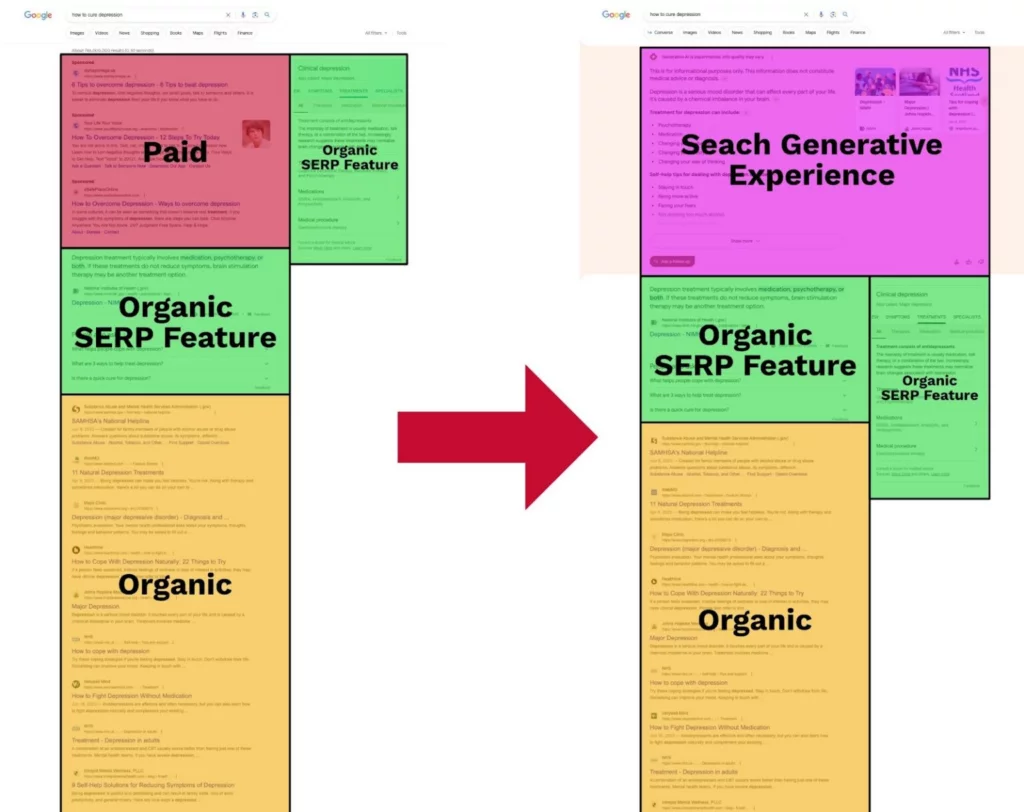How to get traffic from Google in Generative AI era
- by Ilona K.

If you have recently searched something on Google, you might have noticed the results looking different. Jumping in the hot bandwagon of generative AI, Google is now demonstrating a detailed answer to generic knowledge queries in a large block above the website results. While it might come handy for users, it creates a challenge for businesses aiming to generate traffic from Google search. What can you do to stay visible on Google?
What is Google doing with generative AI in search?
Google first broke the news about Search Generative Experience (or SGE) in May 2023. According to the company, SGE aims to transform the search experience on Google with generative AI (familiar to those using ChatGPT or similar services). The idea behind it is to generate a helpful answer to a user’s query without the need to click on links to websites.
SGE, currently available in 7 languages and 120+ countries, allows users to:
- Get answers for detailed descriptive questions asked in natural language;
- Get a relevant top-level answer instantly, and explore further with clicking on links;
- Ask follow up questions while staying on topic
- Generate copy or images within search, etc.

While the benefits for users are clear, for businesses this shift creates a major challenge – especially if your website generates a large share of traffic from Google Search.
How SGE impacts website traffic
Have you ever wondered how your website generates traffic from search? In a nutshell, it works like this:
- The content of your website contains information with certain keywords.
For example, if you sell activewear, your site might be relevant for product keywords like ‘gym shoes’ or ‘yoga pants’ as well as for more informational keywords like ‘how to choose a sports bra’.
- Each of those keywords differs in popularity amongst users in various countries – it is indicated by the metric called search volume.
For example, a monthly search volume (or amount of searches for a keyword) for ‘yoga pants’ in the U.S. is circa 135,000.
- The more relevant your website is for a specific keyword, the more likely you will appear higher in Google search results – which is defined as a keyword ranking.
A bulk of SEO (search engine optimisation) efforts are focused on increasing website rankings for multiple keywords, ideally to a position 1. The higher you rank, the more likely users will click on your website in Google search results (as – let’s admit – no one likes to scroll through the page).
- As a result, you can get a bigger share of the search volume directed to your website, which is measured by a Click-Through Rate (CTR) metric.
Studies revealed that websites ranking #1 can get over 30% of total search volume as organic traffic. Also, results in the first position were 10x more likely to be clicked then position 10. However, this can vary by industry, market and paid search results for a specific query.
- So the amount of organic traffic from a single keyword is roughly equal to the search volume for that keyword multiplied by a CTR for the position your website is ranking for on Google for that keyword. And a total organic search traffic summarises the above for all keywords your website ranks for.
Traditionally, two cornerstones of any SEO strategy were to increase the number of keywords the website is ranking for (thus, increasing the chances to capture more search volume), and to try and rank higher for those keywords (increasing the potential CTR).
With SGE, Google changes the rules of this game in 3 key ways.
- Generative Search Experience results might fill the entire first screen on desktop and will require mobile users to scroll down, adding an extra action to get to organic results.

- Generative Search Experience encourages users to enter specific descriptive queries with multiple variables. It is physically impossible to predict those long-tail 10+ word queries to optimise your website for all of them.
- If a user can get sufficient information from the AI-generated answer, there is no need for them to explore further – meaning that we can expect a rise of so-called zero-click searches. In that case, it won’t matter if you rank #1, as a user simply doesn’t need to click on your website.
- AI-generated answers appear above the list of links to the websites, reducing the chances of further scrolling. Even if a user decides to explore the results beyond SGE, Click-Through rates will inevitably decline, as shown on an example below.

As Google is rolling out the initiative at a rapid pace, it’s important to understand the potential impact of SGE on your website’s performance and try to future-proof your strategy to minimize the losses.
How to future-proof your organic search strategy for 2024
Generative Search Experience still remains an uncharted territory. As it rolls out into more markets and for more keyword verticals, it will become clearer which actions lead to successful results. However, even now you can take some actions to prepare your business for a potential impact from AI in Google Search.
- Collect & analyse data
Identify your top priority keywords that you can’t afford to lose visibility from. Those could be your current position 1-3 ranking keywords for key terms, or the queries you get the majority of traffic from. Using Google Search Labs, check whether those keywords trigger an AI response and which websites it pulls the data from. Analyse what exactly those websites are doing with their content to win the competition. Repeat the analysis regularly and adjust your website content.
- Focus on people-first content
Google has said earlier they would prioritise unique content created by humans rather than generic knowledge or rewrite-style content. Most recently, Google also started showing information about content creators (their social media handles & follower counts) in search results. To show Google your content is people-first, create author profiles in your blog, collaborate with experts in your area to share their perspectives on your website, or engage your employees to post first-hand.
- Create high-quality visual content
Infographics, original images and video content is expected to be less impacted by the new search – and Google actively adds them to AI results. Creating original visual content increases your chances to maintain visibility.
- Boost your product visibility
If your site has ecommerce functionality, make sure your product pages are top-notch. As they are not general knowledge, results for ecommerce queries are less likely to generate an AI-driven overview. Use platforms like Google Shopping to highlight your products.
- Test & learn
There is no one-size-fits-all approach when it comes to AI-generated results. Continue experimenting with your website content, measure results and track impact on your traffic and CTR in order to timely respond to landscape changes.
Looking for ways to future-proof your business strategy online? Visit it.com Domains’ blog and follow us on social media.

Read also




